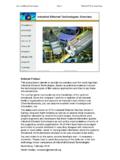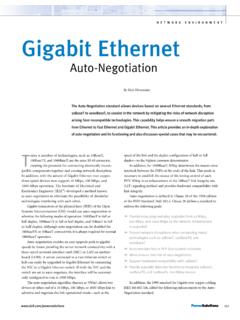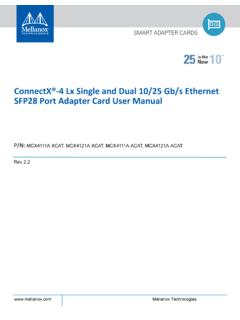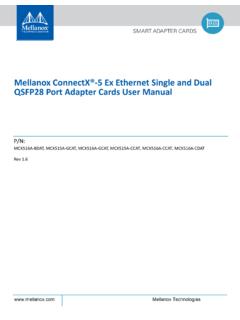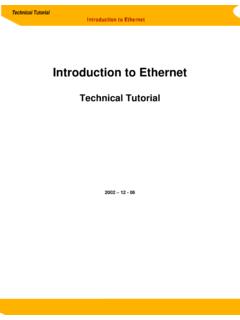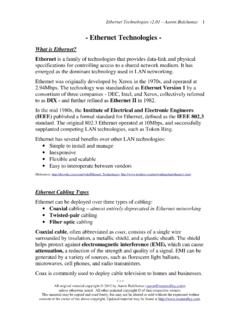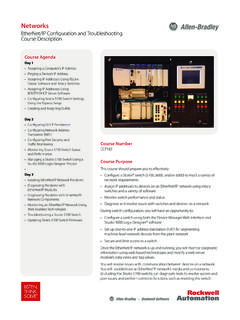Transcription of The Future of CAN / CANopen and the Industrial Ethernet ...
1 The Future of CAN / CANopen and the Industrial Ethernet Challenge by Wilfried Voss, President esd electronics, Inc USA Industrial Ethernet technologies are a formidable challenge to CANopen as the low-cost Industrial networking technology of choice. Ethernet technologies will eventually replace the majority of CANopen applications, at least in regards to new developments. For many years, Controller Area Network (CAN) and CANopen , a higher-layer protocol based on CAN, represented the best choice for low-cost Industrial embedded networking. However, since the official introduction of CAN in 1986, there has been a quest to replace CAN and CANopen to overcome the most obvious shortcomings such as limited baud rate and limited network length.
2 Industrial Ethernet technologies are currently the most formidable challenge to CANopen as the low-cost Industrial networking technology of choice. Ethernet technologies will eventually replace the majority of CANopen applications, at least in regards to new developments, starting at this very moment in certain areas such as Industrial control including motion control and, especially, robotics. Ironically, CAN - the underlying hardware layer of CANopen - has a far greater lifetime expectancy in the North American market than CANopen as a higher layer protocol. However, there can be too much of a good thing, and that is definitely the case when it comes to Ethernet -based fieldbus technologies .
3 There are currently more than 20 different Industrial Ethernet solutions available, all with their distinctive advantages and disadvantages, making a pro/contra decision difficult. The major question, besides the technical aspect, is which of these technologies will survive in the market, and how do they support the current need for control components. In all consequence, the battle between these technologies is a mere marketing battle. This article will elaborate on the Future of CAN and CANopen in the North American market. It will also address the need for faster fieldbus systems and narrow the field of potential winners in the Ethernet race.
4 Distributed vs. Central Control Over the years, CAN and CANopen , due to their economical implementation combined with an extremely high level of reliability, have proven and established their dominance as a fieldbus system for embedded solutions. They were, however, never intended to effectively penetrate the huge North American market for simple Industrial I/O, namely the PLC market. Conventional Industrial controls, especially PLC, are based on Central Control where a single CPU is responsible to control the application tasks, resulting in high performance requirements for the CPU. Another downside is the great amount of wiring resulting in a considerable impact on service and maintenance.
5 Central Control (Distribut vs Central Control ) Distributed Control (Distribut vs Central Control ) Established serial communication technologies for embedded solutions such as RS-485, CAN, TCP/IP, etc. support a Distributed Control architecture in form of Master/Slave or Client/Server configuration. The most obvious advantages are the saving in wiring plus the increased performance of a multi-processor system. There are more benefits resulting from the savings in wiring such as increased system reliability, improved service and maintenance, and, most importantly, reduced downtime and reduced operating costs.
6 The established Ethernet TCP/IP protocol, theoretically 100 times faster than CAN or CANopen , never had the potential to be fully accepted as an Industrial protocol, because it is non-deterministic, it does not support real-time control. Consequently, Ethernet TCP/IP was never a threat to existing CAN and CANopen applications. New Ethernet technologies , such as EtherCAT, Powerlink, Ethernet /IP, etc., however, do have the potential not only to replace existing fieldbus systems, but also to play a major role in the North American PLC market. Advantages and Disadvantages of CAN and CANopen CAN and CANopen , used as fieldbus systems for embedded solutions, combine a number of advantages that cannot be matched by Ethernet TCP/IP.
7 They are: Extreme Reliability and Robustness No Message Collision Very Low Resource Requirements Low-Cost Implementation Designed for Real-Time Applications Very Short Error Recovery Time Support of Device Profiles ( CANopen only) However, there are some disadvantages of using CAN and CANopen , the biggest being the limited network length (~120 feet at a 1 MBit/sec baud rate). The disadvantages are: Limited network length (depending on baud rate) Limited baud rate of 1 MBit/sec Limited bandwidth The following picture demonstrates the relation between baud rate and supported network length: CAN Bus CANopen is basically a software add-on to provide network management function to CAN.
8 The side effect is a reduced CAN bandwidth. The degree of bandwidth loss depends primarily on the use of Service Data Objects (SDO) and Process Data Objects (PDO). Only a meticulous housekeeping can guarantee the best possible performance. In all fairness, the limited bandwidth is not a major problem, since CANopen handles only the communication means between multiple processors (nodes); the major control tasks take place within the nodes, and they do not necessarily effect the bus communication. Houston, we have a ( We re looking for the ) In all consequence, the current excitement about new Ethernet technologies is based on a mere marketing hype.
9 The matter of the fact remains that more than 95% of all Industrial control applications are sufficiently covered by technologies that were established many years ago. It is nevertheless also the case that these new Ethernet technologies are developing steadily closer toward the lower price level of conventional components, and why buy a compact car when you can get a large hybrid SUV with four-wheel drive and better gas mileage for nearly the same price? While it is true that the costs for Ethernet technologies show a tendency to lower prices, the statement nearly the same price can only be regarded as another marketing statement.
10 A tough reality check will reveal that the costs are currently several times higher than those of a conventional system such as CANopen (the estimated factor is somewhere between 3 and 20). However, the technological advantages of Ethernet based fieldbus systems, whether needed or not, are compelling, and they contribute to a higher acceptance level worldwide. The advantages are: Speed! (Currently 100 MBit/sec) Unlimited network length Use of established HW components (RJ-45, Switches, Hubs, etc.) Increased system performance Note: There is currently no information on how Ethernet based fieldbus technologies compare to the high level of reliability and robustness as provided by Controller Area Network.
